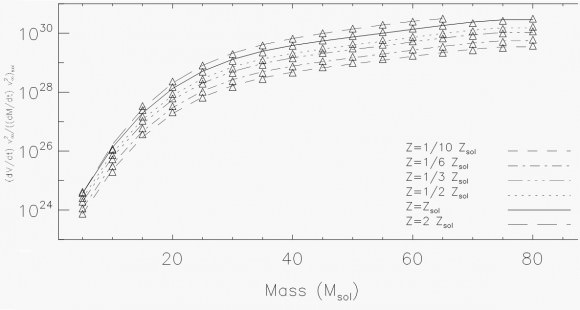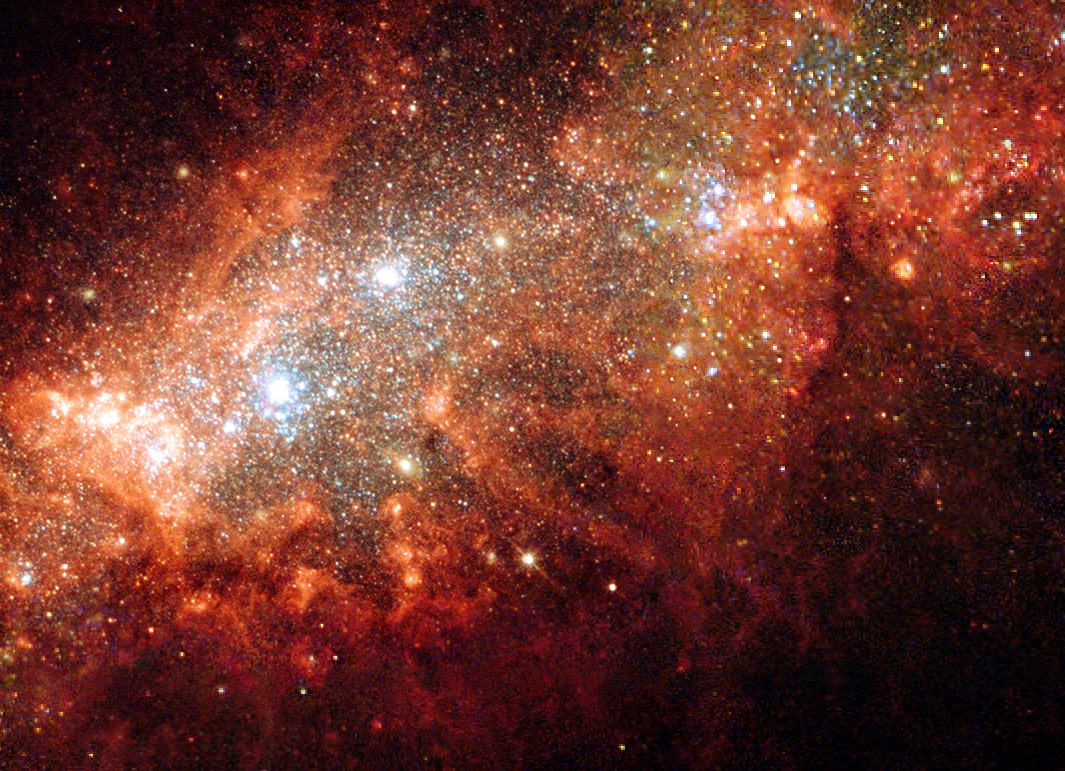[/caption]
Take a cloud of molecular hydrogen add some turbulence and you get star formation – that’s the law. The efficiency of star formation (how big and how populous they get) is largely a function of the density of the initial cloud.
At a galactic or star cluster level, a low gas density will deliver a sparse population of generally small, dim stars – while a high gas density should result in a dense population of big, bright stars. However, overlying all this is the key issue of metallicity – which acts to reduce star formation efficiency.
So firstly, the strong relationship between the density of molecular hydrogen (H2) and star formation efficiency is known as the Kennicutt-Schmidt Law. Atomic hydrogen is not considered to be able to support star formation, because it is too hot. Only when it cools to form molecular hydrogen can it start to clump together – after which we can expect star formation to become possible. Of course, this creates some mystery about how the first stars might have formed within a denser and hotter primeval universe. Perhaps dark matter played a key role there.
Nonetheless, in the modern universe, unbound gas can more readily cool down to molecular hydrogen due the presence of metals, which have been added to the interstellar medium by previous populations of stars. Metals, which are any elements heavier than hydrogen and helium, are able to absorb a wider range of radiation energy levels, leaving hydrogen less exposed to heating. Hence, a metal-rich gas cloud is more likely to form molecular hydrogen, which is then more likely to support star formation.
But this does not mean that star formation is more efficient in the modern universe – and again this is because of metals. A recent paper about the dependence of star formation on metallicity proposes that a cluster of stars develops from H2 clumping within a gas cloud, first forming prestellar cores which draw in more matter via gravity, until they become stars and then begin producing stellar wind.

Before long, the stellar wind begins to generate ‘feedback’, countering the infall of further material. Once the outward push of stellar wind achieves unity with the inward gravitational pull, further star growth ceases – and bigger O and B class stars clear out any remaining gas from the cluster region, so that all star formation is quenched.
The dependence of star formation efficiency on metallicity arises from the effect of metallicity on stellar wind. High metal stars always have more powerful winds than any equivalent mass, but lower metal, stars. Thus, a star cluster – or even a galaxy – formed from a gas cloud with high metallicity, will have lower efficiency star formation. This is because all stars’ growth is inhibited by their own stellar wind feedback in late stages of growth and any large O or B class stars will clear out any remaining unbound gas more quickly than their low metal equivalents.
This metallicity effect is likely to be the product of ‘radiative line acceleration’, arising from the ability of metals to absorb radiation across a wide range of radiation energy levels – that is, metals present many more radiation absorption lines than hydrogen has on its own. The absorption of radiation by an ion means that some of the momentum energy of a photon is imparted to the ion, to the extent that such ions may be blown out of the star as stellar wind. The ability of metals to absorb more radiation energy than hydrogen can, means you should always get more wind (i.e. more ions blown out) from high metal stars.
Further reading:
Dib et al. The Dependence of the Galactic Star Formation Laws on Metallicity.


I have not read the paper yet, but there seems to be two competing processes brought about by metalicity. The formation of molecular hydrogen is a positive process and the stellar wind a negative process. The two may interplay in some complex manner.
LC
Check – although the paper does not dwell on the first process (just a passing reference to Kennicutt-Schmidt relation). Agree the potential for interplay is of interest.
Equation 1.1 and 2.1 seem to reflect the competing processes. I am not sure whether this is worth pursuing, but there might be some nonlinear dynamical process here. This might be involved with selecting the distribution of stellar types on the main sequence. This might be different in the past, say 5 billion or 10 billion years ago, from the distribution of stars formed today.
LC
What an excellent article, so good to see something on a web site at a level beyond Jayne’s mass but still very approachable. I shall be reading the paper.
I am not into this, but I think there are several effects involved.
First, atoms over hydrogen and molecules have more energy levels (from populated shells for both, and vibration and rotation modes for the latter) as suggested in the article, so can radiate over a wider spectra. That ought to be important in dynamic situations (rapid cooling) and even for the first stars in a universe where radiation was decoupled from atoms.
Second, the internal energy modes of molecules spread energy over such modes too, taking a bit off the other heat motions. Every little bit should help.
Third, dust begets dust, as anyone cleaning has noticed. Molecules doesn’t form readily by two atoms and/or ions colliding due to momentum consideration. Isolated molecules collisions would tend to make them bounce, since the momentum very rarely match an outgoing molecule.
Hence a surface, in effect a third body to accommodate momentum with, speeds up gas reactions immensely. Dust provides such a surface.
So it’s not the amount of gas, its how spicy it is, that kills the neighborhood.
I am curious how that affects planet system formation.
Apparently the same cooling effects makes giant gas planets form more readily. While the jury is out on terrestrials. One way to interpret HARPS’s results is that terrestrials form readily regardless of star metallicity. But HARPS and Kepler aren’t agreed yet.
But high metal stars would, presumably from the above, finish its formation process faster. The planets could be left in larger orbits when initial migration stops. That difference could have something to do with the different exoplanet methods as of yet differing results.
Agree the dust helps the cooling and the clumping, but hydrogen is the dominant factor -hence the prime relation is that H2 correlates with star formation efficiency. Dust (metals) then overlays that relation as a second facor.
‘So it’s not the amount of gas, its how spicy it is, that kills the neighborhood’. Well, no – both factors are significant, as above.
One assumes dust provides the material for terrestrial exoplanets – so there is metal dependency at that level for starters.